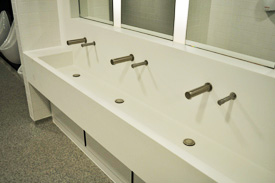Solid surface wash troughs
Contents |
[edit] Introduction
Solid surface wash troughs are a low-maintenance, cost-effective alternative to individual handwash basins. Comprising a long, narrow basin with a tap for each user, a hand wash trough can accommodate multiple users while requiring far less plumbing than an individual basin.
Instead of filling the wash trough with a mixture of hot and cold water, as with an individual basin, wash troughs are normally fitted with a mixer tap which supplies water ready mixed at a comfortable hand-washing temperature. Fitting a thermostatic water mixing valve, which ensures that the water delivered to the tap does not exceed a specified temperature, can help reduce the risk of scalding and ensure user comfort.
[edit] About solid surface
Solid surface was invented by DuPont in the late 1960s as a low-cost, low-maintenance alternative to natural materials such as marble and granite. The initial product from DuPont was called Corian, but since the expiration of the patent, a number of other manufacturers have begun producing solid surface products, such as Formica and Hi-Macs.
While the composition of each product varies, solid surface is typically made up of natural minerals (such as marble dust or bauxite) and pigments, suspended in an acrylic polymer resin.
The unique properties of solid surface mean it can be joined together almost seamlessly by thermoforming, whereby the material is heated and moulded into the desired shape before being cooled again to set.
While it is most often used to make kitchen countertops, the versatility of solid surface material means that it can be used in any number of applications. Solid surface is particularly useful for wash troughs because it is both seamless and impermeable; this prevents water from pooling and creating the conditions that allow bacteria and mould to flourish.
Solid surface wash troughs are available in a huge range of colours and designs. They can also be custom made to suit the dimensions and aesthetic of any washroom.
[edit] How are solid surface wash troughs made?
Sheets of Solid surface material are cut to size and then heated to make them malleable. The softened sheet is then quickly placed onto a mould and transferred to a thermoforming machine, which uses a vacuum to draw the solid surface material to the shape of the mould. This process is repeated for each individual component. Finally, the individual pieces are joined together and sanded down for a smooth, seamless finish.
[edit] Where are they used?
Solid surface wash troughs are rarely used in a domestic setting; they are much more commonly found in high-traffic venues such as public conveniences, workplaces and schools.
In fact, the Department for Education and Skills (now called the Department for Education) recommended wash troughs over individual basins in its Toilets in Schools guidance, stating that they are ‘easier to clean, aesthetically more pleasing, and reduce the potential for pupils to flood the toilets’.
[edit] Cleaning a solid surface wash trough
Solid surface material is easy to clean and does not require specialist detergents or cleaning products; simply wash the surface with warm soapy water or any ammonia-based household cleaner.
To avoid scratching the surface of the wash trough, you should use a soft microfibre cloth, and never abrasive cleaning pads or scourers. Using a circular motion when wiping the wash trough will ensure the best finish.
Periodically, ‘deep clean’ solid surface wash troughs. To do so, spray down the wash trough with a mixture of three parts household bleach and one part water, then leave overnight. In the morning, remove the residue with a damp cloth before rinsing thoroughly.
This article was originally written by Paul Thorn, MD of Washware Essentials, who provide a range solid surface wash troughs. They also supply urinals, toilets and accessories.
[edit] Related articles on Designing Buildings
Featured articles and news
RTPI leader to become new CIOB Chief Executive Officer
Dr Victoria Hills MRTPI, FICE to take over after Caroline Gumble’s departure.
Social and affordable housing, a long term plan for delivery
The “Delivering a Decade of Renewal for Social and Affordable Housing” strategy sets out future path.
A change to adoptive architecture
Effects of global weather warming on architectural detailing, material choice and human interaction.
The proposed publicly owned and backed subsidiary of Homes England, to facilitate new homes.
How big is the problem and what can we do to mitigate the effects?
Overheating guidance and tools for building designers
A number of cool guides to help with the heat.
The UK's Modern Industrial Strategy: A 10 year plan
Previous consultation criticism, current key elements and general support with some persisting reservations.
Building Safety Regulator reforms
New roles, new staff and a new fast track service pave the way for a single construction regulator.
Architectural Technologist CPDs and Communications
CIAT CPD… and how you can do it!
Cooling centres and cool spaces
Managing extreme heat in cities by directing the public to places for heat stress relief and water sources.
Winter gardens: A brief history and warm variations
Extending the season with glass in different forms and terms.
Restoring Great Yarmouth's Winter Gardens
Transforming one of the least sustainable constructions imaginable.
Construction Skills Mission Board launch sector drive
Newly formed government and industry collaboration set strategy for recruiting an additional 100,000 construction workers a year.
New Architects Code comes into effect in September 2025
ARB Architects Code of Conduct and Practice available with ongoing consultation regarding guidance.
Welsh Skills Body (Medr) launches ambitious plan
The new skills body brings together funding and regulation of tertiary education and research for the devolved nation.
Paul Gandy FCIOB announced as next CIOB President
Former Tilbury Douglas CEO takes helm.
UK Infrastructure: A 10 Year Strategy. In brief with reactions
With the National Infrastructure and Service Transformation Authority (NISTA).























